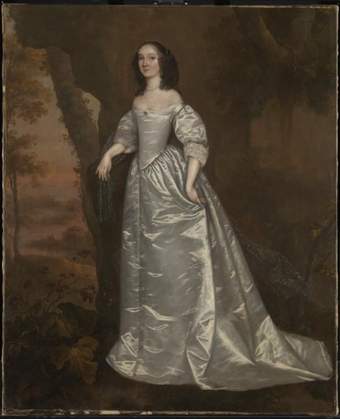
Fig.1
Joan Carlile c.1606‒1679
Portrait of an Unknown Lady
1650‒5
1107 x 900 mm
T14495
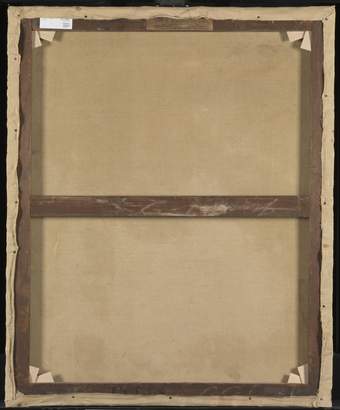
Fig.2
Reverse of Portrait of an Unknown Lady

Fig.3
George Wilkinson and Son label on the top bar of the stretcher, rotated for ease of reading

Fig.4
Portrait of an Unknown Lady in ultraviolet light
This is painted in oil (fig.1), on a plain woven canvas, lined with glue paste to a canvas that is recent in appearance, and attached to a stretcher of nineteenth- or earlier twentieth-century date. The lining canvas has, unusually, not been trimmed at the back (fig.2), nor are the corners turned over and fixed in the neat and economical way typical of a company of professional canvas liners. The top bar of the stretcher bears a paper label for George Wilkinson and Son (fig.3), upside-down with respect to the painting and partly covered by the untrimmed lining canvas, stating that this company was established in 1870, and carried out ‘picture cleaning and restoring, picture frame making and renovating, carving and gilding’.1 Debatably, there is a second neatly trimmed and finely woven lining canvas present between the support which Carlile painted upon, and the modern canvas. Wilkinson and Son might have carried out this first lining, and also supplier a new stretcher (the one in use today): there was possibly varnish removal and varnish replacement at the same time, which usually followed a lining treatment. Before the sale of the painting and acquisition by Tate, yellowed varnish had been removed, minor retouching done to small paint losses, and a new varnish had been applied by the Gillespie Studio in London. This retouching appears as dark spots in the ultraviolet image (fig.4). This company stated that it had not carried out the lining to modern canvas, nor substituted the labelled stretcher for the original one. The non-standard lining procedure must have been done in recent decades, after Wilkinson’s treatment but before that at the Gillespie Studio, by another individual, possibly not a professional, who re-used the stretcher upside-down, and who may also have removed and/or replaced varnish and/or treated the paint surface with unknown reagents.
Carlile’s canvas has obvious cusping on the lower edge only, which means that all the other edges are likely to have been trimmed by at least 10‒15 mm during a past treatment.2 This could argue for trimming either by Wilkinson and Son, by the unknown individual, or even by both.
Not many paintings by Joan Carlile, the first recognised female professional painter in England, have been attributed at the time of writing, though both the artist herself and the identity of her aristocratic sitters are being actively researched. Some of her portraits of women have been illustrated recently.3 Few of these include the train of the gown cropped at the edge of the canvas as it is here, and all have the woman placed lower in the composition, with a taller and arched rocky outcrop behind her, revealing a distant landscape beyond, sometimes facing the opposite way although in a similar pose. Tate’s portrait might therefore have been considerably higher, somewhat wider at the right, but only slightly wider at the left: together these dimensional changes would give the central placement of the woman’s head but not her train, which is a feature of the other female portraits.
The white or pearl grey satin gown in Tate’s portrait features in a number of the others, sometimes with a different distribution or colour of silk knots trimming the bodice, the waist and the central front seam of the skirt. The gown must have belonged to the artist, and in effect was a studio prop. In all the known and illustrated comparative portraits, the depiction of the satin fabric is very similar and it is always white or pearl grey in colour.

Fig.5
Cross-section taken from brown outcrop at the top edge, imaged at x320, showing thin mixed brown paint, the much thicker mixed pinkish priming, and the transparent brownish ground

Fig.6
The same cross-section as in fig.5, imaged at x320 in ultraviolet light, showing that the ground too is thick compared to the paint layer
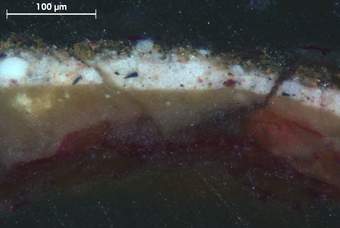
Fig.7
The same cross-section as in fig.5, imaged at x320 after staining with crimson-coloured acid fuchsin. Only the canvas fibres have been stained positively for protein
There is a pale pink oil-based priming present everywhere, made from lead white,4 charcoal, a non-fluorescent red lake (perhaps cochineal, but it was too sparse for analysis) on an unusual substrate of dolomite (magnesium carbonate), brown natural earth pigments and Vandyke brown, with traces of copper that cannot be accounted for by the pigments that are present. This might indicate a copper-containing drier used in the oil-based medium. This priming was applied quite thickly (compared to all other layers that are present, see figs.5 and 6) over a pale brown ground that includes chalk, possibly some gypsum too, and a fine brown earth pigment. In some cross-sections, this ground looks very transparent and brown (fig.6), because it has absorbed glue paste lining adhesive. Staining of the cross-section for protein did not give a positive result however (fig.7), which suggests that the ground medium was oil-based.
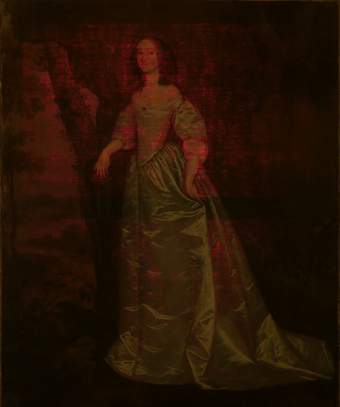
Fig.8
Portrait of an Unknown Lady in transmitted light, with the thinnest areas of paint showing as red
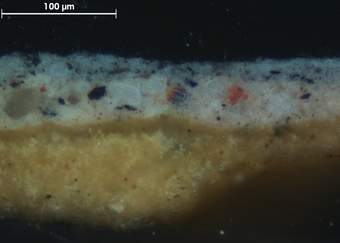
Fig.9
Cross-section showing grey paint for the gown painted directly over the pink priming, imaged at x250
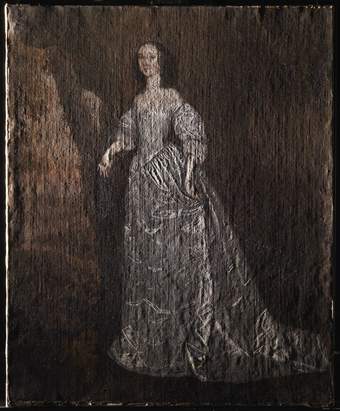
Fig.10
Portrait of an Unknown Lady in raking light from the left
The woman’s figure appears from the transmitted light image (fig.8) to be painted into a reserve, that is, an area of unpainted priming reserved for the form when the landscape was painted first. This was confirmed by cross-sections from the skirt (fig.9), which in places such as the highlight at the outer edge of the train runs over landscape paint. The transmitted light image (fig.8) indicates that the paint for the figure, as well as that for the landscape, is mostly very thin except for the highlights on the fabric. The view of the canvas in raking light (fig.10) confirms how thin and even the paint now is, though the earliest treatments did contribute to its uniform thinness, since they removed paint as well as varnish.
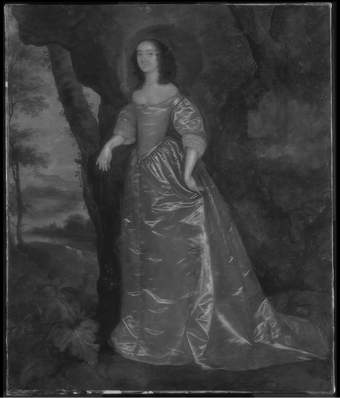
Fig.11
Infrared reflectogram
Image: Silvia Amato and Aviva Burnstock
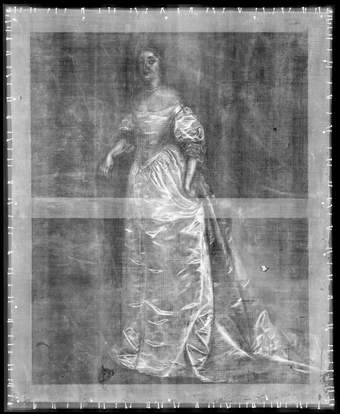
Fig.12
X-radiograph of Portrait of an Unknown Lady
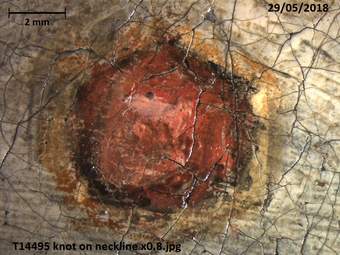
Fig.13
Photomicrograph of the embroidered knot at the centre of the neckline
Very thin and light underdrawing can be discerned where the right lower arm emerges from the sleeve, but not so readily elsewhere, though it does exist. Infrared reflectography (fig.11) suggests that the landscape round the head was reworked.5 However, the X-radiograph (fig.12) does not seem to indicate any compositional changes. However, the paint is so thin that slightly more impasted details such as the pink knots at the centre of the neckline, the base of the bodice, and the central front seam of the skirt are scarcely rendered obvious in the X-radiograph despite their undoubted content of lead white pigment (fig.13) – which means that any compositional changes in such thin paint would not be rendered successfully either.
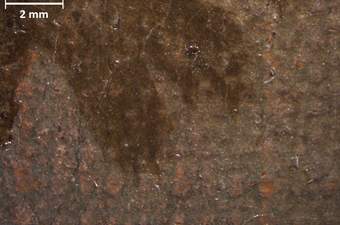
Fig.14
Photomicrograph of a browned leaf over the brightest blue area of the sky, with pink priming visible on the tops of the canvas threads
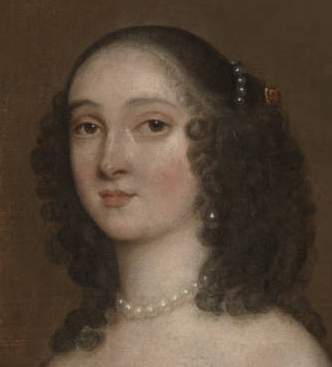
Fig.15
Detail of the face
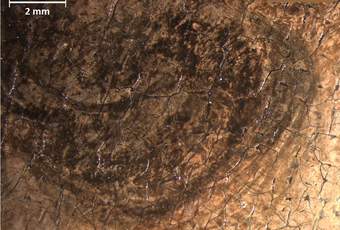
Fig.16
Photomicrograph of the loose curl on the proper right shoulder
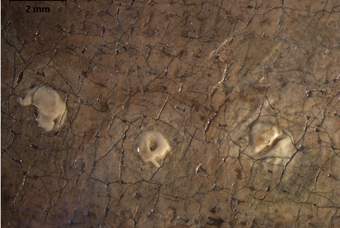
Fig.17
Photomicrograph showing three identical round pearls in the necklace
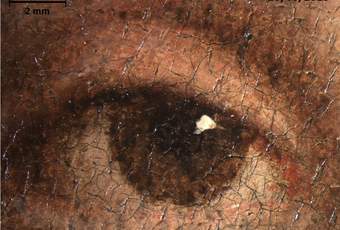
Fig.18
Photomicrograph of the right eye
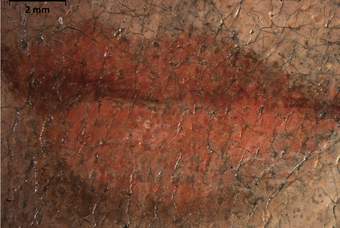
Fig.19
Photomicrograph of the lips
The pink priming was not used as a mid-tone, but it is visible under magnification in much of the sky, on the tops of the canvas threads where the paint lies most thinly (fig.14). The thinly-applied curls round the face (figs.15‒16) are as thin as the paint layers in the background, as are the pearls which consist almost purely of a catch-light on a skim of pale wash for each separate pearl (fig.17). The painting of the eyes with a catch-light utilised a similar technique, but the paint for the eye socket was skilfully blended and is thicker than the rest (fig.18). The lips were applied thinly over the flesh paint (fig.19). The thickest paint of all was used for the sunny highlights of the buildings in the distant landscape (fig.20). The ultraviolet image (see fig. 4) suggests that a modified oil-based paint medium or an added paint drier might have been used for the costume, but not for the landscape, which fluoresces less.
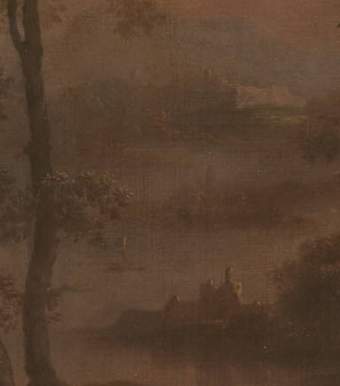
Fig.20
Detail of the islands and buildings in the far distance, lit by the low sun
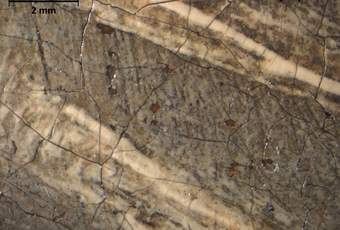
Fig.21
Photomicrograph showing a highlight on the satin, at the third knot from the hem
The dark brown paint for the leaves against the sky includes brown natural earth pigments and chalk, with traces of barium sulphate. The paint for the dull green foliage includes yellow and brown natural earth pigments, a lot of blue azurite, with red vermilion and bone black used for redder leaves, with a deep green that may be of copper resinate type used in a few places. The copper resinate has saponified,6 since it seems to have little particulate structure now, and it retains its characteristic strong bluish green tone in only a few tiny places, and only when viewed under magnification. Highlights in the foliage consist of a single brushstroke of thick opaque yellow or dark red paint, but otherwise the foliage often consists of two layers of mixed green, the uppermost more medium-rich and glaze-like, both very thin, with the upper one applied as thinned paint. The blue paint for the sky includes a lot of very pale (or now discoloured) smalt in one sample, but another sample includes azurite, possibly from very thinly painted foliage on top. The satin gown is painted in lead white and bone black, with the lighter grey highlights applied with a single yet substantial brushstroke apiece (fig.21).
Thus, the painting technique was very simple, rapid, and rather formulaic, with a single thin application of paint for coloured elements, modified in tone by a more glaze-like thin layer for the landscape, and by simple modelling highlights for the gown, each applied with confidence and only once. The knots and pearls were painted in swiftly, each knot with a few strokes of colour and each pearl with a single catchlight, in a rapid and assured manner that produced a string of identical-looking pearls. All paint layers except the pink priming and brownish ground are thinner than is typical for the period.
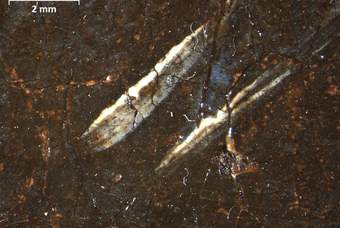
Fig.22
Photomicrograph showing a highlight on the gauzy shawl flowing behind the figure, and a trace of blue for the fabric
The pink priming has saponified to such a degree that it is full of lead soap aggregates (LSAs), which make it appear more transparent and darker, therefore more pink than when applied. This reduces the legibility of the entire surface. The paint layers also show significant LSA formation, but less so than the pink priming. (The brown ground has no lead white, hence no LSA formation is possible here. But it has been made more transparent by absorbed lining adhesive, which feeds into the same change in overall appearance.) Only the white modelling strokes and highlights on the satin gown, and the red knot at the centre of the neckline (see fig.13), more thickly painted than the knots bordering the bodice and on the skirt, retain any opacity. The gauzy shawl is only visible behind the figure as scattered highlights (fig.22) rather than obvious fabric, due to its greatly increased transparency in consequence of LS formation. Because it overlies the dark landscape and not the grey satin of the gown, it looks even more insubstantial. All of the background now appears rather transparent, dark, and very pink, the light blue sky being affected the most. The pale grey satin and the flesh paint are less affected, but details applied on top, like the curls and the pearls, have grown very transparent too, giving an impression of greater wear and overcleaning than has really occurred. Some of the LSAs from the pink priming have pushed through the overlying paint of the costume, giving the impression of a scrubbed-away paint surface. In fact saponification of the lead white rather than overcleaning has caused the overall pink cast and the impression of very insubstantial and dark paint.
Since the painting was treated and varnished before acquisition, no further treatment has been planned. At acquisition, the painting had no frame, and an appropriate one is being made at Tate.
October 2018
